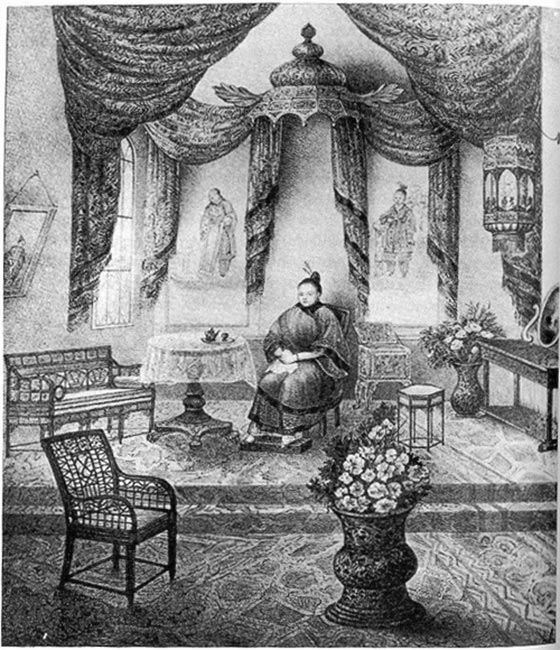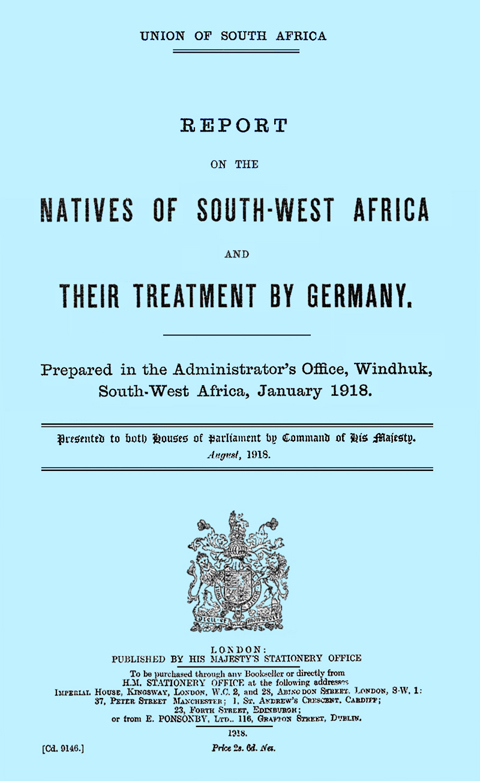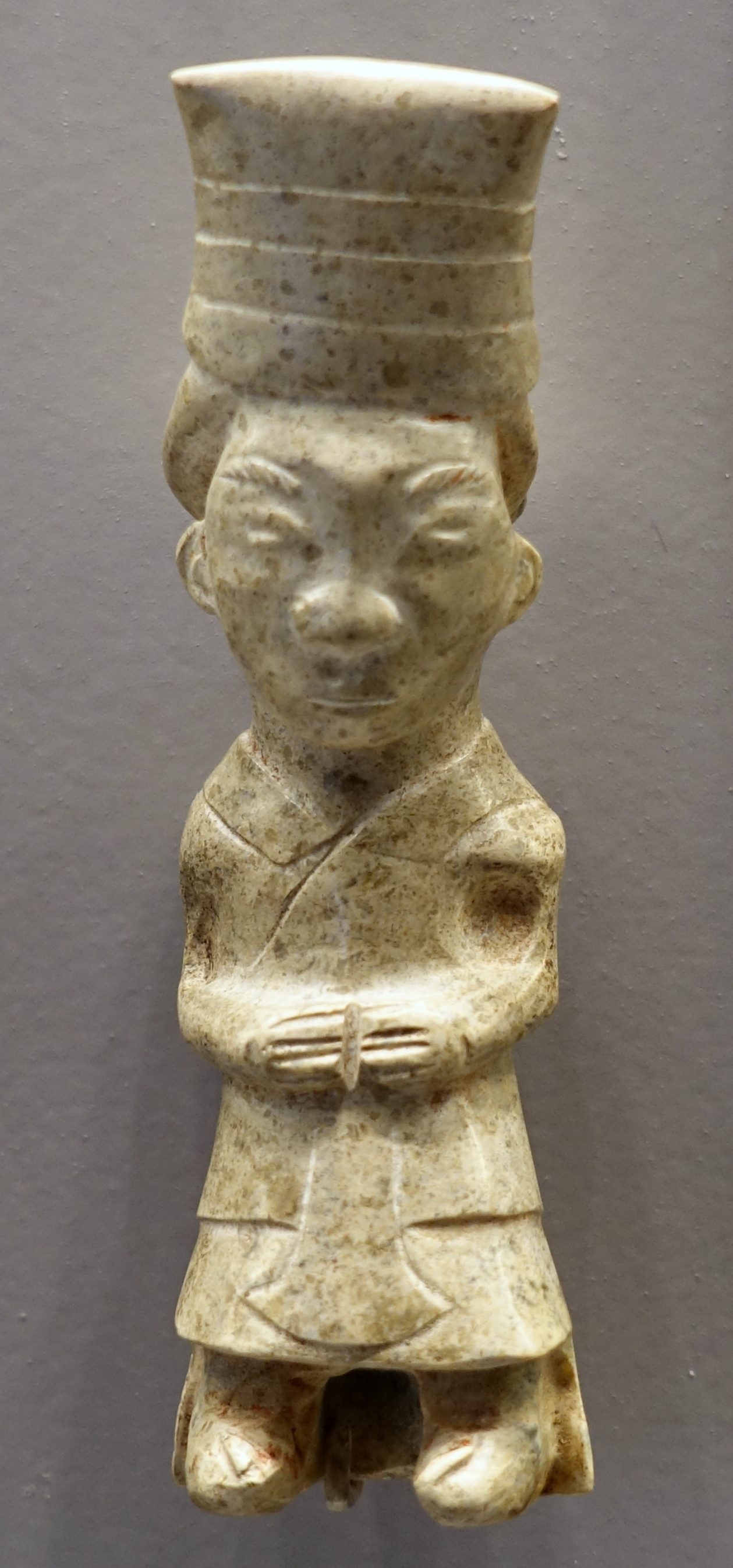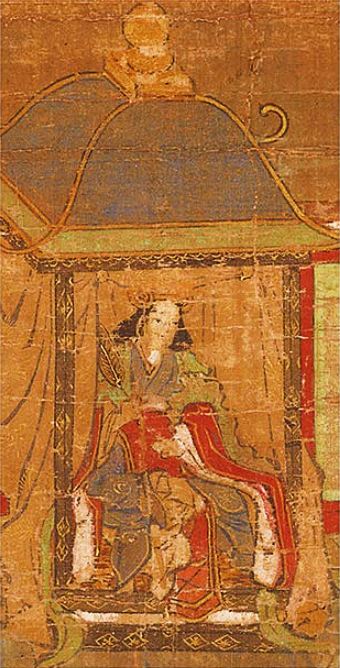This essay looks at the Kimonope attire adopted by North American Dancehall artists Shenseea (Chinsea Linda Lee hereafter | 1996 - present ) for the video to 'ShenYeng Anthem'. Whilst the aesthetic derives mostly from East Asian, principally Chinese aesthetics, the language used is specifically Japanese, referring to Chinsea Linda Lee as 'ShenYeng Boss', a perpetuation of the Dragon Lady stereotype to boot.[11] The essay mostly charts how this ridiculous Kimonope derides from the North American Anti-Chinese movement and how this intersects with contemporary Orientalism.
Shenseea
Lee is from Jamaica, as were her parents. Her father from whom she is estranged however, was based in Korea where he worked when Lee grew up. The father of her child is from the mainland of North America, the US. Lee's video portrays the Dragon Lady trope, a stereotype used to delegitimize the agency of East Asian women in so called 'white' spaces which is curious given her family background.
Anti-Asian and Race Origins
Anti-Asian hate began in Europe when groups like the Huns began to invade and live amongst the Eastern Europeans in the 5th century CE creating the Turkic diaspora, pushing previously Iranian and Germanic groups into the Roman Empires realms.[1] After this, jealousy over wealth disputes continued with the silk trade until the arrival of the Mongols under Genghis Khan (1162-1227) between 1220-1240 CE who pushed for Mongol expansionism as far as Meissen Germany.[1] After this, greater awareness of the 'Orient' a mostly Iberian term returned to describe 'Oriental Moores/Saracens' homelands during the Reconquista to 'reconquer' the Al-Andalus (Muslim Medieval Iberia) from (718)1100-1492 CE, introduced Orientalism into European medieval literature. The Orient just being a word meaning 'East', derived from Roman sources (c.300CE, see Glossary).
Combined, these stories of outsider 'Hordes' (Mediterranean and Asian) invading Europe began to get European Christian scholars knickers in a twist. In their desperation to combat the 'Hordes' (other/perceived threat) and win the Crusades against the 'Saracens', scholars like Otto von Freising (1114-1158CE) began to make up myths about Christian kings who lived far far away in the East~, who would come to save them and together, Asia, or India, or Africa or ??? would come to save the poor European Christians. A prime example being Freising's Prester John (c.1145CE) who wanted to come from a country East of the Tigris to avenge the Crusaders, but unfortunately was a bit busy at the time so instead he decided he would just stay East instead.[3]
In 1177, Pope Alexander III (1105-1181) sent word, requesting Prester John's assistance from one of his now 72 kingdoms.[3] Prester John it seems was based on Otto's missattribution of Prester John with the Christian Buddhist dynasty of Yelü Dashi in 1141 (1087-1143CE) defeating Iranian warlords.[4] With the changeover to the Yuan Dynasty these changes became more appealing to Italian and Viennese merchants when China for the first time was ruled by a non-Han ethnic group. At the court of the Berke, eventually came the Polo family whose son Marco (1254-1324) travelled extensively for as a merchant. Eventually returning home, Marco spread the tale of the 'Far East' and extensive silver deposits.
Later, the Iberian trade routes which were sent to find India, Goa specifically were cited by people like Christopher Columbus as #inspogoals for finding these countries where maybe Prester John existed in his Nestorian Christianity haven. Either way, by the time Vasco de Gama landed in Calicut India in 1498, this started the beginnings of Portuguese and Spanish colonial interests in Asia, supposedly to bring Jesus to the Pagans, but mostly to bring back silver and wealth via monopolized trade routes. During the next century when these Portuguese Jesuits landed in Japan by 1543, they had begun undermining local authorities, denying Kirishitan converts access to higher positions and generally followed the rule of 'Divide and conquer' to gain their ends.
This had been done successfully since Henry the Navigator had landed in West Africa (1415) to find new trade routes, the most lucrative of which being the pre-existing trade network of slaves which stretched from Morocco to India at that time. Portuguese merchants promoted the idea of race based domination after Gomez de Eanes Zurara (in 1453) defended the Iberian slave trade by asserting that Africans or POC were inferior to their captors, therefore they were 'natural slaves'. Thus Zurara created the first distinct racial/racialist hierarchies or 'scientific racism'.[5]
In order to have capital grow in the budgets of the Iberian kingdoms, foreign assets (slaves) were bought and kept in bondage, and this eventually was expanded to entire cities, cultures, counties, kingdoms and later countries whose borders were redrawn to suit European and often in early ventures Iberian needs (for example Puerto Rico). It was said 'racism is the consequence of slavery'.[6] Thus, Portugal became rich by subjugating other groups, pitting people against one another and eventually bringing an areas resources under its control to profit from these. Or as Francisco de Olandia explained during the San Felipe Incident (1596), 'Spain gained its empire by first converting native populations to Christianity with missionaries and then sending in conquistadors to join the newly converted in an invasion of conquest.'[7] After the Catholic Church encouraged this subjugation of fellow man under the Discovery Doctrine (see Dum Diversas 1453), this set in motion the wheels of race based hierarchies by the 16th century, which lead to the initiation of European global colonialism.
Anti-Chinese
Anti-Chinese sentiment had been around since the days of the 18th century when European powers began to trade with China under Chinese stipulations, Anti-Chinese because the 'free markets' were not 'free' enough for the European monopolies multinationals. When the Opium Wars and other European colonial wars kicked off in the 19th century, these brought instability to China and caused massive migrations from an impoverished Chinese mainland which later became known as the Century of Humiliation. This marked rise in emigration saw increased numbers of emigrants to Global North countries like Murica, Canada, Australia and Europe (not a country).
One of those who was trafficked or travelled to America was the young lady Afong Moy (c.1815-c.1850) who in 1834 was brought to be displayed in an early example of something akin to a Human Zoo, where she was put on display with other 'Chinese' objects in a bid to sell 'Chinese wares' for the American business brothers the Carnes. By 1848, she had ended up in the poor house when the brothers refused to send her home. Whilst Moy had some agency in dispelling othering rumours, she is also thought to have engendered early stereotypes about the Chinese being a 'backwards race' and was penultimately used a showpiece for selling furniture. Moy may have been the first instance of the China Doll trope, that is an East Asian women who performed for mostly White Men in a submissive manner, almost object like stillness. Bostonians referred to Moy as having 'her feet cut off and stuck into a couple of turnips' as 'well worth looking at' for their 'native nakedness' for example, that is a highly othered exotic image of womanhood to be gawked at, humiliating and depriving Moy of her dignity.[10] This morphed by 1850 into the highly subservient sex worker China Doll stereotype, sex workers making up a good majority of the 'frontiersmen' who wear at the beck and call of white men.
As usual, Murica was one step ahead of all of the other ones and started to deprive Chinese American communities of their rights and dignity early on. In 1852 with the arrival of increasing numbers of gold miners to California, fresh off the genocide of Native Americans, Chinese emigrants were charged a head tax because they were Chinese.[8][9] The Chinese Exclusion Act of 1885 effectively banned all 'coolies' from entering Murica, a legal trend carried on into Canada between 1923-1947, Australia between 1901-1973 and in New Zealand the head tax continued from 1881-1944. Continuing this, Murica's seperate but equal assertions saw PlessyvFerguson (1896) until the fight for civil rights won its first major victory in 1965, saw the Chinese community segregated into 'China Towns', both to appease white majority opinion and to protect Chinese-Americans from white violence.
Yellow Peril
Put together, these stereotypes are part of the 'Yellow Peril' racist ideology which is specifically Anti-Asian or against 'yellow' people. The term 'Yellow Peril' began life as the German propaganda phrase of Die Gelbe Gefahr stemming from the Orientalist 'scholar' Max von Brandt in a time where Germany was courting the favour of European states like Tsarist Russia from 1871-1895. This marked favouritism towards White nation has been a consistent theme of German-Japanese Relations, intitally frosty at their start in 1861, and only thawed by the WWII. I say thawed as Japan was on the Allied side in WWI, defeating the Germans at Tsingtao and only actively courted German interests in the 1930s as it was worried about the attempted takeover of GEACPS resources in South East Asia.[9]
Wilhelm II (1859-1941) was a staunchly white supremacist, overseeing the German genocide in Namibia (then German South West Africa) later on and implementing the rigid 'Gelbe Gefahr' stance against Japan when it became an active Imperial nation in 1895. In reaction to Japan winning against China, he sent the infamous 'Peoples of Europe, guard your most sacred goods' painting depicting the looming 'Other' threat on the horizon as anthropomorphically opposite 'Us' stood ready to defeat this 'Gelbe Gefahr'.[9]
Dragon Lady
Begun with Wong Liu Tsong's stereotypically cast roles, the Dragon Lady trope began with the Character 'The Dragon Lady' in Terry and the Pirates (1934), a caricature of Wong's femme fatale roles from films like Daughter of the Dragon (1931). The Dragon Lady trope can be thought of as the feminine counterpart to Fu Manchu who first appeared in Sax Rohmers Zayat Kiss (1912), in turn based on the yellowface performer William Ellsworth Robinson (stage name Chung Ling Soo; 1861-1918) stage act arguably begun becuase Robinson was a sore loser who could not beat his Chinese counterpart Ching Ling Foo ( 金陵福 | 1854-1922) at illusion as a theatrical performer or even personality, going so far as to steal his identity, ethnicity, job and then went on to impersonate Chung Soo to spite Chung and humiliate Chung based on his work ethic (to his peers) and ethnic identity (or 'race').
The Dragon Lady Trope is a subversion of acceptable white proximity, that is how much a POC can pass for white. The Lotus Blossom stereotype predates the Dragon Lady precisely because the Blossom/Geisha trope placed Asian women as submissive, docile and subservient to white men in the stories of Loti, Long and Golden. By being dominating and assertive, Wong at least used her agency as a powerful star to pursue representation much in the manner of Hattie McDaniels. When McDaniels for instance was asked why she had played the Mamie stereotype in Gone with the Wind, it was in the acceptable Norms of the times and spaces McDaniels could move in, much as with Josephine Baker who had to wear a string of Bananas to be palatable to French Audiences to fit in the 'primitive' mold of colonial 'native' populations.
For all that Black and Asian beauties were on screen, this is unfortunately where these liberties ended. It is in being palatable, non-threatening and percieved as 'inferior' that some white people only feels safe with approaching POC, Queers and Indigenous topics and people. It is in this vein that when a celebrated Musician 80 years on perpetuates tired internalized racism/colourism tantamount to yellowface, that this emboldens the diseased types to carry on with their assertions of soft-power subjugation.
Unless I am missing the point, this setup plays very well into the lascivious Geisha stereotype of sexually available objectified bodies, stemming from the Page Act 1875 which stereotyped Chinese and Asian women sex workers and going into the 1910's tropes catalogues, Orientalist stereotypes of the Lotus Blossom and 'Chinese Doll' types. It only appears to transform the trope at all by playing on the cues of the Dragon Lady trope as placing the feminine as superior to the male, even then ridiculing East Asian accents (perhaps Chinese, or Japanese?) and culture out of context and for money no less.
Kimonope
The Kimonope involved is not particularly familiar with anything other than the likes of Fools performative yellowface, stemming from a Wilsonian reworking of history. The trim is more reminiscient of Hanfu styles, the maquillaje irreverently evoking Tang-fastics. The thing resembles a red Furisode that had a lovechild with a golden bathrobe embroidered with dragons.
Overall, a very classic Kimonope, playing more into bizarre Orientalist tropes than trying to use KTC as a transformative way to develop new ways of affirming or normalizing POC agency in the Global North.
Conclusion
Overall I think it is important to understand these are internalized notions of race popularized by the North American framework of it through the work of American Minstrel shows, Robinson the Fool, China Doll and Dragon Lady stereotypes and political narratives which pushed the Yellow Peril agenda. By wearing this Kimonope alone, it could be transformative in discussing how groups like African-Americans and Chinese-Americans subvert these stereotypes (think Bakers adoption of the primitive aesthetic, Wong's understanding of the times she lived in and her role as representative), however in playing dress up in another groups cultural adjacent garments Longinguistically, it is hoped Lee understands she is playing into the hands of groups who have purposefully subjugated, demeaned and profited from cultural appropriation in close proximity to racist supremacist ideals.
Bibliography
[1] https://en.wikipedia.org/wiki/History_of_the_Huns#Historical_impact
[2] https://en.wikipedia.org/wiki/Mongol_invasion_of_Europe
[3] http://www.mirandakaufmann.com/prester-john.html#:~:text=Prester%20John%20was%20a%20mythical,onwards%20increasingly%20associated%20with%20Ethiopia.
[4] https://en.wikipedia.org/wiki/Prester_John
[5] https://www.washingtonpost.com/local/a-brief-history-of-the-enduring-phony-science-that-perpetuates-white-supremacy/2019/04/29/20e6aef0-5aeb-11e9-a00e-050dc7b82693_story.html
[6] https://www.jstor.org/stable/2953315
[7] https://en.wikipedia.org/wiki/San_Felipe_incident_(1596)
[8] https://en.wikipedia.org/wiki/New_Zealand_head_tax
[9] Japanese-German Relations 1895-1945: War; Diplomacy and Public Opinion, The Yellow Peril and its influence on Japanese-German Relations, Iikura Akira, 2006, pp.80-81
[10] https://www.nyhistory.org/blogs/afong-moy-the-chinese-lady
[11] https://www.youtube.com/watch?v=l94vCs0vtbE
Essay Abstracts
#1 Renee Vivien (1877 - 1909) --- Born Pauline Tarn, was an English lesbian poet. She wrote in French and perhaps English. She took up the style of the Symbolists and Parnassinism and was well known during the era of the Belle Epoque (the Beautiful Age) for producing Sapphic verse and living as an open quasi butch lesbian poet; her verse derived from the ancient poet Sapphos, also famed for her love of women.
# 2 Birth of the Kimonope --- Here I shall introduce the notion of the Kimonope, that is as a garment attached to the social construct of the 'Geisha' in North America. Kimonopes being Orientalized clothing, or 'negatively affiliated or exoticized ethnic dress' which lead to the perceived notion of the Kimono and Geiko as simultaneously both high and low culture to American culture makers, such as film, television, media, writers and some academics. An example of Kimonope are the tacky Halloween costumes you may find at the Dollar store.
#3 The Legacy of the MacArthur Dynasty on KTC & The Problem with the 'Traditional Garment' Argument --- The problem with arguing that the Kimono is a 'Traditional ethnic Garment' is that that assertion is in itself, arguably Ethnocentrism, which to clarify is the imposition of, in this case, American values onto Japanese cultural values, belaying the 3 pronged pitchfork of idiocy.
#4 Divine --- Government name Harris Glenn Milstead (1945-1988) was the infamous North American Queen & Drag artist. Specifically, Divine was known for being a character actor, part of her act is well-known for its eccentricity. My personal exposure to Drag lite was Pantomine Grand Dames as a kid, and later when my friends made me watch RuPaul in art classes, so to me this is nothing new, the over the top, the glitter, the upstaging is all part and parcel.
#5 Dori-Style or 21st century Kimono Fashion --- The Dori-Kimono style. Something which I just made up because in going over notes for the first 20 years of 21st century section of Kimono history, I noticed a lack of a clear catchall term for what was happening in Japan at the time, at least in English descriptions of the time. I use the term Dori as I do not want to coin an unrelated term to the topic, but I also am reticent to claim all of Street style as 'Tori' either, whilst a large number of streets upon which the subculture originates in all use the suffix 'dori' (the bottom of Takeshita-dori for example), thence Dori-style.
#6 The Tea Gown --- This essay will cover the aspects of how 19th century Japanese import textiles to Western countries were used and repurposed, as well what their desirability tells us about how Japanese design was regarded and the image which these people held of Japan through the Western lense and consciousness. This follows the progression of how Kimono can be used in the West from the undress of the 1860s, adapting silk bolts in the 1870s to high fashion western daywear, to the 1880s aesthetic movement and 1890 wholesale adoption in the Victorian age to being used prominently by society hostesses as tea gowns by the Edwardian period, and the subsequent change in Japanese export culture which we see in extant textile collections of Japanese textile in Western dresses of the periods.
#7 Kimono and the Pre-Raphaelite Painters --- This essay will cover the aspects of Kimono in the Portraiture of the Pre-Raphaelites. The Pre-Raphaelites were a group of British artists and writers active during the late Victorian period. Unlike the Royal Academy artists, this circle of painters operated outside of the established comfortable boundaries of the expected white, cisgender middle class audience of the Victorian age. The movement is notable for its inclusion and encouragement of women, and in portraying and engaging non-conventional beauty and beauties as figures from the Classical World alongside Religious, Mythological and Folklore Heroines into Victorian 'Femme Fatales'.
#8 Jokyo/Genroku Kimono Textile Culture and the new role of the Komin --- This essay will return back to GKTC (Genroku Kimono Textile Culture ; 1688-1704) and JoKTC (Jokyo K.T.C. 1684-1688) and the new role of the Komin (Artist caste) in GKTC. JoKTC is notable for being the lead up to GKTC, JoKTC being characterised by its transitory nature in comparison to GKTC, which was far more bold in its relations to what Kosode could and should be. Komin entered the picture at this juncture, and I shall elaborate a little more here than in other posts about why that was. GKTC is notable for its elaborate, perhaps gaudy and innovative Kosode design features, whilst JoKTC more so for the enabling factors of the time, as a sort of incubatory GKTC.
#9 Tagasode Byobu - This essay will explore the art motif known in Japanese art as Tagasode Byobu ( Whose sleeves Screen) This motif is a recurring art form which was particularly popular during the Azuchi-Momoyama era ( 1568-1600 ) as a representation of the ways in which Buddhist sensibilities met with the fast changing events of the end of the Sengoku Jidai (1467-1615) and as an extension of the habit of wealthy women from military families came to own and store a large number of Kimono. Prior to this, Kin Byobu ( Golden Screens) for the most part depicted nature like Sesshuu Touyou (1420-1506) after Chinese Cha'an painter Muxi ( c.1210-1269 ) or 'flower-and-bird' scenes like those of Kano Eitoku (1543-1590), rather than humans or human paraphernalia as an extension of the Zen painting school of thought about materialism.
#10 Cultural Acculturation --- The topic of our essay is on the nature of Cultural Exchange in KTC which will be an ongoing mini-series throughout 2022. This covers the 1000CE - 1500 period in Japanese History.
#11 Cultural Appropriation --- The topic of our essay is on the nature of Cultural Appropriation which will be an ongoing mini-series throughout 2022.
#12 Cultural Acculturation --- The topic of our essay is on the nature of Cultural Acculturation which will be an ongoing mini-series throughout 2022. This covers the Asuka (Hakuho), Nara (Tempyo), and Heian periods (500CE-1000CE) in Japanese History.
#13 Asai Ryoi --- This essay will explore the legacy of Asai Ryoi on KTC. Who was Asai Ryoi you may ask? Only one of the most important writers for the Ukiyo genre. Asai Ryoi ( act. 1661-1691 ) was a prolific Ukiyo-zoshi ( Books of the floating world ) or Kana-zoshi ( Heimin Japanese Books ) writer. His leading 1661 publication, lambasted and satirized Buddhism and Samurai culture of restraint in favour of the Chonin lifestyle of worldy excess.
#14 Edith Craig --- This is a post regarding the early adoption and promulgation of the Kimono and Japanese aesthetics in the life of the wonderful Edith Craig (1869-1947), daughter of the famous actress Ellen Terry (1847-1928) and Edward William Godwin (1833-1886). Edith was also known as 'Edy'.
#15 European Banyans --- This essay will explore the European garment known as a Banyan, which originated as a European reaction to Kimono in the 17th century, popular until the end of the 18th century. The word Banyan originates from Arabic ( Banyaan), Portuguese (Banian), Tamil ( Vaaniyan ) and Gujarati ( Vaaniyo ) loanwords meaning 'Merchant'. Alternative versions saw the item fitted with buttons and ribbons to attach the two front sides together. The Banyan was worn by all genders and was particularly regarded in its first iterations as a gentlemanly or intellectual garment worn with a cap to cover the lack of a periwig, and later adopted by women and greatly influenced how British womens garments were designed with preference for comfort in removal of panniers whilst maintaining luxurious, modest 18th century fashions (see Robe a la Anglaise).
#16 Miss Universe and Kimonope --- This essay will explore how Beauty Pageants, principally Miss Universe, has engaged with KTC. While there may be real Kimono worn by Japanese and Japanese adjacent contestants in the 'National Costume' category, I will be focusing on the Kimonope worn by contestants. The idea of Kimono as a 'national costume' sparks interesting conversations on what 'national costumes' are, their target audiences, and how we form ideas about these things to begin with.
#17 Onna-E --- Womens pictures refers to the Nara, Heian and early Kamakura ( 710-1333CE ) practice of drawing women in elongated Hand scrolls, which today are regarded as feminine gender coded Art. Some of these narratives depict the lives of women, their extra diaries, or the literature they wrote. The Onna-E style derives from how mostly Heian women represented themselves and others as a performed self in these scrolls, drawing from their lives indoors at their and the imperial abodes. Whilst a limited number of women could read Kanji, they also used their knowledge of Chinese culture to create and inspire their own culture; the first truly Wamono aesthetics; and it was with these preconditions that Onna-E became established in the Japanese art scene alongside Yamato-E and Oshi-E.
#18 A Jamaican, a Monster and Portuguese bar in the Orient --- This essay looks at the Kimonope attire adopted by North American Dancehall artists Shenseea (Chinsea Linda Lee | 1996 - present ) for the video to 'ShenYeng Anthem'. Whilst the aesthetic derives mostly from East Asian, principally Chinese aesthetics, the language used is specifically Japanese, referring to Chinsea Linda Lee as 'ShenYeng Boss', a perpetuation of the Dragon Lady stereotype. The essay mostly charts how this ridiculous Kimonope derides from the North American Anti-Chinese movement and how this intersects with contemporary Orientalism.
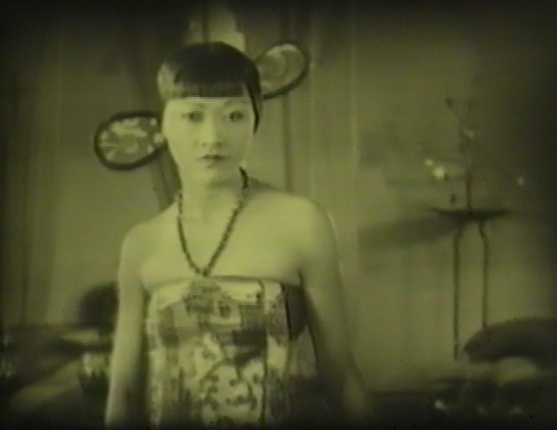
.jpg)

